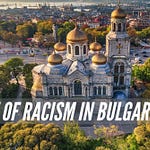Europeans and their colonial offshoots have been told they are descendants of crusading slaveholders who did nothing to stop the Holoc**st. To the world, Europe has become the “mother of monsters”. By submissively embracing guilt, the West has given its enemies a reason to be murdered us with migration. Those unwilling to accept their forthcoming genocide must first look for a new myth.
Speech
Every culture has a foundation myth that tells people what to believe about themselves. Pueblo Indians, for example, believe they are children of Father Sun. It gives them time to unfold their personalities and to live life as complete persons.1
But Europeans and their colonial offshoots have been told they are descendants of crusading slaveholders who did nothing to stop the Holocaust. To the world, Europe has become the “mother of monsters”.2
German guilt has infected all of Western civilization. By submissively embracing guilt, the West has given its enemies a reason to be murdered with migration. Those unwilling to accept their forthcoming genocide must first look for a new myth.
Scene Break: Europe’s Conversion
All of Europe converted to Christianity by the late thirteenth century. The conversions began in Rome under Emperor Constantine, followed by the submission of northern heathens.
The Great Schism of 1054 split the church into an Orthodox east and a Roman west. In 1517, Martin Luther’s theses instigated the Reformation that would divide Western Europe into a Catholic south and a Protestant north.
The three halves of Christianity now roughly gravitate around the eastern Slavic peoples, the Germanic peoples of the north, and the peoples south of the rivers Rhine and Danube whose ancestors had once lived under the reign of the Roman Empire.
But according to psychoanalyst Erich Fromm, Europe’s “conversion to Christianity was largely a sham”.3 He meant our ancestors submitted to the church and adopted Christian symbols, but that their spirits remained heathen. Nevertheless, church missionaries successfully erased the memory of a heathen past.
In The Netherlands, the first Bishop of Utrecht, Villibrord, helped the heathens forget their ways. As early as the year 695 AD, he ordered the demolition of a statue near the town of Westkapelle, a statue of Wotan, the chief god from Norse mythology also known as Woden or Odin.
If the thirteenth-century Icelandic poems contained within the older Poetic Edda and the younger Prose Edda represent the pagan beliefs of Nordic peoples, their fire-and-ice world was one inhabited by dwarfs, giants and warring families of gods.
Among them, we find popularized gods such as Freya, Odin, his son Thor, and the sun-god Tyr. Their names live on in several European languages as the days of the week: Tuesday, Wednesday, Thursday, and Friday are Tyr’s, Woden’s, Thor’s and Freya’s days.
The same is true for the Celtic gods Mars, Mercury and Jove who are remembered in French language as the weekdays mardi, mercredi and jeudi. Incidental similarities between the beliefs of old and new helped the church spread the Christian faith. Missionaries could map pagan patriarchs onto the Trinity of God (Odin), the Son (Thor) and the Holy Spirit (Tyr).
This eased the transition.
Scene Break
Winter solstice rituals held in late December were replaced by Christmas. Christ’s resurrection is now observed during Easter, which used to be a spring fertility festival. The word for Easter comes from an Old English goddess named Ēostre, a dawn goddess.
Not all pagan rituals were erased, though. Many of Europe’s children still celebrate Saint Nicholas, a christened tradition also called Santa Claus in the United States. Santa, of course, is Odin in disguise.4
Fromm was right about Europe’s conversion. Christian missionaries didn’t erase Europe’s heathen spirit. They superimposed their symbols onto it. But the original sin trapped Europeans in a belief in their weakness, a powerful weapon unmatched by any Roman artillery.
If the Roman Empire couldn’t thwart the invading hordes, it could plant feelings of guilt and shame among the barbarians in order to sabotage their minds. No amount of crucifixions ever intimidated the guilty heathens, at least not until Constantine began parading Rome’s most innocent victim.
Scene Break: Resistance Wars
To the citizens of Rome around the time of emperor Augustus, over 2,000 years ago, “the land north of the rivers Rhine and Danube must have been the Third World,”5 according to present-day historian Christoph Pantle in his book Die Varusschlacht, or The Varian Disaster.
Rome had built outposts along the Rhine and Danube from present-day Utrecht in the west, then called Traiectum ad Rhenum, all the way to the Black Sea in the east. But why did it take Christian missionaries centuries to convert all of Northern Europe?
One reason is that the Northern Europeans remained strongly patriarchal tribes ruled by their native aristocracy, who often, despite their later conversions to Christianity, held on to their pagan way of life, and were thus able to halt the desert cult’s more insidious influences.
The Germanic tribes who lived to the east of the river Rhine were a technologically simple people, but they fiercely resisted Roman presence in their lands. Averaging over five foot and seven inches tall, the males of Germanic tribes were physically superior to Roman soldiers who averaged at least an inch shorter, despite being Rome’s tallest.6
Julius Caesar’s campaigns into Celtic and Germanic territories had begun between the year 58 and 51 BC. Nowadays, we think of Caesar as a great tactician and military genius, but students of history take note of his genocidal acts against other Europeans:
“With a few lapidary sentences, Caesar paints a picture of a crime of enormous proportions. He speaks of 430,000 enemies—women and children included—and the Romans practically killed all of them.”7
Caesar exaggerated the numbers, but he didn’t understate his crimes against Germanic and Celtic families. For the next seventy years, successive Roman generals Drusus, Tiberius, Varus, and Germanicus would go on campaign after campaign to slaughter the stubborn northerners. Roman legionaries sometimes exterminated entire tribes of the Germani.8
Eventually, most tribes living near the Rhine were forced to submit to Roman rule, but many did not, notably the Cherusker. Their chieftain, known only by his Latin name Arminius (17 BC-21 AD), would successfully halt further Roman expansion into his territories with a series of resistance wars.
The most notable of Arminius’s battles became a historic turning point of which the consequences are still felt today. At the Battle of the Teutoburg Forest, which took place around 9 AD, Arminius and a group of conspirators commanding a tribal alliance lured three Roman legions into a trap near present-day Osnabrück. They butchered nearly all the over 15,000 soldiers plus thousands of civilian staff members.9
General Quintilius Varus felt so ashamed of his defeat that he committed suicide while his men were still fighting for their lives.10 Once news of the unprecedented disaster arrived in Rome, Emperor Augustus was so upset he wouldn’t shave his beard for months, “and dashed his head against a door, crying: ‘Quintilius Varus, give me back my legions!’”11
For centuries, the history of Arminius’s deeds was lost and forgotten. Only a single copy of the work on the Germanic peoples by the Roman historian Tacitus survived in the form of a codex from the mid-ninth century. It was rediscovered in 1455 by Enoch von Ascoli in the library of the Hersfeld monastery in Germany.12
The discovery sparked renewed interest in the history of the Germanic peoples. Under pressure from the Roman Catholic Church, Protestant German humanists now began discussing their ancestors’ positive sides.13 Arminius was given a new name and became Hermann the German.14
Modern Germans now had their own Spartacus, their leader of the slave revolt against the Roman oppressor. Even Protestant reformer Martin Luther wrote around 1540, “If I were a poet, I would celebrate him. I love him from my heart.”15
Hermann’s legend would play a significant role in the development of German nationalism. Arminius effectively united the German tribes twice, once in his day, and again in the 18th century. Arminius and his Germanic conspirators defeated the full force of the Roman Empire.
The shock-wave the defeat sent throughout history can literally be heard today, for it is the reason why Northern Europeans still speak their indigenous Germanic languages rather than romanized ones: Swedish, Norwegian, Danish, Icelandic, Faroese, Dutch, German, and to a large extent even English.
The outcome of the Battle of the Teutoburg Forest explains why Northern Europeans later broke with the Roman Catholic Church: they had never been integrated into the Roman Empire to begin with. From the fifth century onward, several Germanic tribes moved to Britain and blended with locals to become the Anglo-Saxons.
About one thousand years later, the Anglo-Saxons settled in North America and founded the United States.16 During the colonial age, many descendants of the Germanic tribes who had withstood the Roman Empire would now transplant themselves to the Americas, South Africa, Australia, New Zealand and other places.
They played a significant role in the Industrial Revolution. They may be regarded as the fathers of modern civilization.
Scene Break: A New Myth
The post-war foundation myth of Western civilization is a negative one that ties our existence to the Holocaust.
It means we have come to believe the world will be better off without us, that we should, finally, surrender to Rome, as it were, and accept our genocide through miscegenation, through the forced marriage between Europe and Africa.
Our only hope for salvation, supposedly, is to welcome immigrants into our holy Asgard, and do all we can to expedite our extinction. Arminius withstood the Roman Empire, because he wanted his people to live in freedom, and because he wanted to win Thusnelda’s love.
The young couple set an example for all people of European descent. They showed that there is nothing shameful about defending one’s culture and traditions against the destructive forces of globalism.
When Tacitus wrote his book on Germany around 98 AD, Arminius had been dead for just 77 years when the historian noted,
“They say that [Thor], too, once visited them; and when going into battle, they sing of him first of all heroes.”17
If the Jews once adopted an orphaned baby from the Nile as their patriarch, if Christians chose the adopted son of a carpenter to be their messiah, and if Muslims turned to an orphaned desert merchant as their prophet, then wouldn’t it fit the liberator of all of Germany to be adopted by his kinsmen as the son of God?
If it is true that much of European Christianity is an old pagan faith wrapped in Christian symbols, then Arminius may be closer to us than we think. If Arminius’s legend lived on in the myth of Thor, and if Christian missionaries mapped the gods of Norse mythology onto their Trinity, then perhaps it is time to attack the cross with a pair of pincers and start pulling out some nails.
Tell the son of God to be a man again. Europe has suffered long enough.
C.G. Jung et al., Man and His Symbols (London: Dell Publishing, 1964), pt. I: “Approaching the Unconscious: The Soul of Man.”
C. G. Jung, Collected Works of C.G. Jung, Volume 10: Civilization in Transition (Princeton University Press, 2014), chap. III: “After the Catastrophe,” para. 404.
Erich Fromm, To Have or to Be, Kindle (New York: Continuum, 2008), chap. VII: "Religion, Character, and Society: Is the Western World Christian?".
Arnold-Jan Scheer, Wild geraas: Mijn wonderlijke reizen met Sinterklaas en kerstman, 1st ed. (Soesterberg: Uitgeverij Aspekt, 2014).
Christian Pantle, Die Varusschlacht: Der germanische Freiheitskrieg (Berlin: Propyläen-Verlag, 2009), chap. “Einführung: Zeugen der Vergangenheit.”
Pantle, chap. 1: "Vorspiel," para. 1: "Erster Zusammenprall".
Pantle, chap. 1: "Vorspiel," para. 3: "Caesar erobert Gallien".
Tacitus and Grant, The Annals of Imperial Rome, bk. XII, chap. 39.
Pantle, Die Varusschlacht, chap. “Einführung: Die Falle.”
C. Velleius Paterculus, The Roman History (London: Loeb Classical Library, 1924), bk. II, chap. 119.
C. Suetonius Tranquillus, The Lives of the Twelve Caesars (Loeb Classical Library, 1913), bk. II, chap. 23.
Daniela Sechtig, Arminius Vs. Siegfried: Die Entwicklung Des Germanischen Helden in Der Deutschen Literatur (Diplomica Verlag, 2008), 7.
Sechtig, 8.
Pantle, Die Varusschlacht, chap. “Vorwort.”
Martin Luther, Tischreden, ed. Johannes Mathesius (Eisleben, 1566), para. 5415.
Pantle, Die Varusschlacht, chap. V: “Nachspiel,” para. 2: “Weichenstellungen.”
Tacitus, De origine et situ Germanorum, chap. 3.










